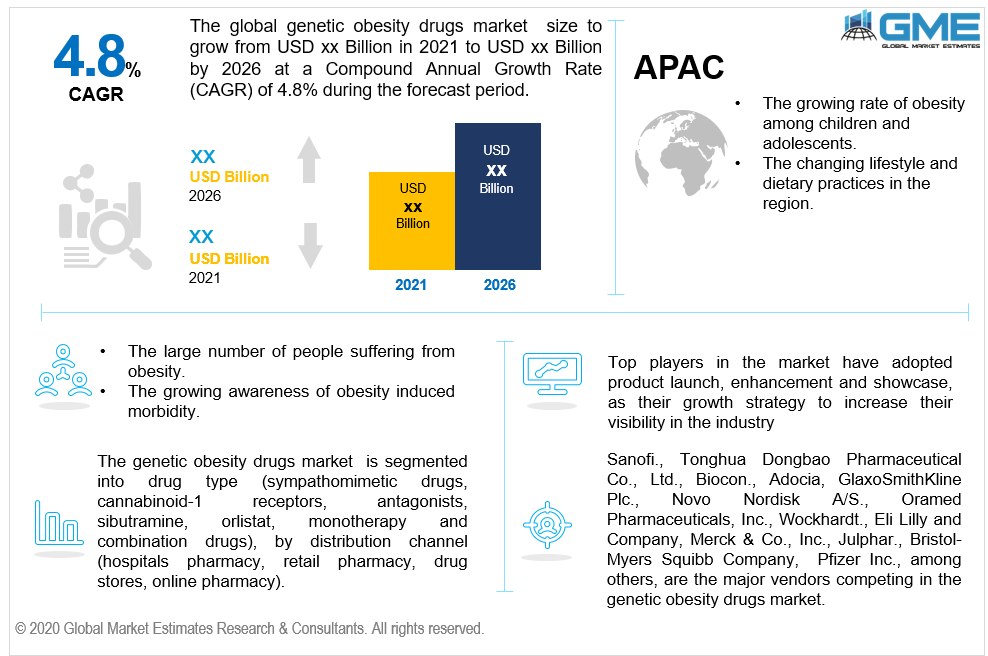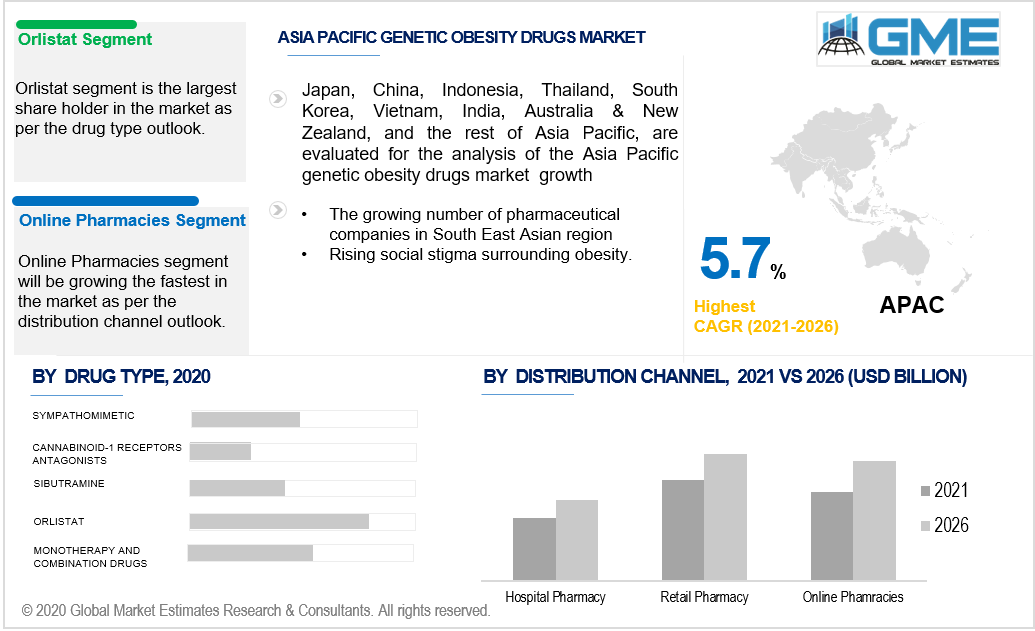
Global Genetic Obesity Drugs Market Size, Trends, and Analysis - Forecast To 2026 By Drug Type (Sympathomimetic Drugs, Cannabinoid-1 Receptors, Antagonists, Sibutramine, Orlistat, Monotherapy, and Combination Drugs), By Distribution Channel (Hospitals Pharmacy, Retail Pharmacy, Drug Stores, Online Pharmacy), By Region (North America, Asia Pacific, CSA, Europe, and the Middle East and Africa); End-User Landscape, Company Market Share Analysis & Competitor Analysis
Obesity is one of the most common disorders afflicting the human population. Obesity is a condition where the body fat levels have increased by such an extent that it causes immense stress on the human body. Obesity is commonly defined based on one’s body mass index (BMI greater than or equal to 30 kilograms per meter square). Obesity is caused by a mismatch in energy intake and energy expenditure. It has slowly become one of the largest and fastest-growing health concerns among the population in developed and developing nations. It is estimated that around 30 to 35% of the population of the U.S. are obese and around 25% of the population in the UK suffer from obesity. The number of obesity cases among children and adolescents is increasing, and the prevalence of obesity among children and young adults is expected to double by 2025. Obesity is a result of the low metabolism rates of the human body. Low metabolism rates result in the storage of fat in the human body leading to obesity.
Obesity leads to various health issues. Obesity can lead to increased morbidity, large healthcare costs, and poor quality of life. Obesity can increase morbidity as it can result in an increased risk of type 2 diabetes, hypertension, metabolic syndrome, dyslipidemia, stroke, and some types of cancer. Obesity is one of the major factors in the U.S., with over 300,000 cases annually that can be attributed to obesity. The stress on healthcare facilities and the costs in the U.S. alone is expected to cost over USD 100 billion on an annual basis. Prevention of obesity through education and advocating lifestyle changes are long-term solutions that can help prevent a further increase in the number of cases of obesity. Treatment options for obesity are limited and lifestyle changes like dieting and exercising are increasingly proving to lead to sustainable weight loss in large parts of the population.
Cognitive behavior therapy is another form of treatment for obesity but it is not viable for mass application thereby limiting their use in treating obesity. Gastric binding and other bariatric surgeries are more effective measures of weight loss. Surgical complications need for reoperations, and reversible benefits for morbidly obese people has resulted in the need for other treatment. Obesity drugs are an alternative to the above-mentioned techniques. Obesity drugs can reduce body weight by either decreasing absorption of food or by decreasing consumption. Various technological advancements from heavy investments in the research and development of new drugs are expected to increase the demand for obesity drugs in the coming years. Novel genetic obesity drugs that can recover appetite and inhibit the hormone levels in the body are being developed. The genetic obesity drug market is hampered by the side effects of genetic obesity drugs. Genetic obesity drugs can cause various problems like cardiovascular issues and liver damage in extreme cases. Many drugs have been outright banned or heavily regulated by governments due to the harmful side effects of genetic obesity drugs. Genetic obesity drugs are usually not covered by health insurance providers which increases the financial burden on patients which limits the use of genetic obesity drugs. Pharmaceutical companies spend large amounts of money on the research and development of genetic obesity drugs which leads to high prices for the drugs which reduce the customer’s ability to purchase these drugs.

Based on the various types of drugs available to treat genetic obesity, the genetic obesity market can be segmented into sympathomimetic drugs, cannabinoid-1 receptors, antagonists, sibutramine, orlistat, and monotherapy and combination drugs. The monotherapy and combination drugs segment is expected to register the fastest growth rate during the forecast period. Sympathomimetic drugs and sibutramine drugs were used extensively to treat obesity but the side effects of these drugs have discontinued their usage. Currently, many combinations of drugs like phentermine and topiramate, bupropion and naltrexone, and other combinations of drugs are used to treat genetic obesity. Orlistat is expected to hold the dominant share of the market during the forecast period. Orlistat genetic obesity drugs prevent the absorption of calories from the ingested food. Orlistat is available as an over-the-top medication which is one of the major factors of the dominance of this segment.
Based on the various distribution channels, the genetic obesity market can be segmented into hospitals’ pharmacy, retail pharmacies, drug stores, and online pharmacies. The online pharmacy segment is expected to register the fastest growth rate among all regions. For a decade, E-Commerce has been successful in becoming heavily popular across the globe. Online stores are convenient for consumers as they will not have to travel to various stores to find the desired product. Online pharmacies will deliver the products and makes genetic obesity drugs accessible to people in remote areas.

The North American region is expected to hold the dominant share of the market during the forecast period. The North American region has a large obese population with almost 35% of the population being obese. This region has been spending immense capital on healthcare infrastructure which has helped it to be the dominant segment in the market. North America is also home to various pharmaceutical companies and has large research and development activities which increase the number of new products being developed and released in the region.
The APAC region is expected to register the fastest growth rate among all regions. The region has a growing number of cases of obesity due to changes in lifestyle and improved economic stability. The region has a large number of contract pharmaceutical manufacturing firms which are expected to increase the demand for genetic obesity drugs in the region. The growing awareness of obesity-related morbidity is also expected to increase the demand for genetic obesity drugs in the region.
Sanofi, Adocia, Tonghua Dongbao Pharmaceutical Co., Ltd., Glaxo SmithKline Plc., Novo Nordisk A/S., Wockhardt, Biocon, Oramed Pharmaceuticals, Inc., Merck & Co., Inc., Julphar, Eli Lilly and Company, Pfizer, Inc, Bristol-Myers Squibb Company, among others, are the major vendors competing in the genetic obesity drugs market.
Please note: This is not an exhaustive list of companies profiled in the report.
We value your investment and offer free customization with every report to fulfil your exact research needs.
The Global Genetic Obesity Drugs Market has been studied from the year 2019 till 2026. However, the CAGR provided in the report is from the year 2021 to 2026. The research methodology involved three stages: Desk research, Primary research, and Analysis & Output from the entire research process.

The desk research involved a robust background study which meant referring to paid and unpaid databases to understand the market dynamics; mapping contracts from press releases; identifying the key players in the market, studying their product portfolio, competition level, annual reports/SEC filings & investor presentations; and learning the demand and supply-side analysis for the Genetic Obesity Drugs Market.

The primary research activity included telephonic conversations with more than 50 tier 1 industry consultants, distributors, and end-use product manufacturers.

Finally, based on the above thorough research process, an in-depth analysis was carried out considering the following aspects: market attractiveness, current & future market trends, market share analysis, SWOT analysis of the company and customer analytics.

Tailor made solutions just for you
80% of our clients seek made-to-order reports. How do you want us to tailor yours?
OUR CLIENTS